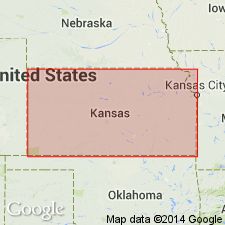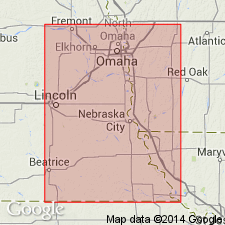
- Usage in publication:
-
- Lawrence shales
- Modifications:
-
- Original reference
- Dominant lithology:
-
- Shale
- Sandstone
Summary:
Pg. 122. Lawrence shales. Shales, interbedded with sandstones, 210 feet thick, including a thin limestone exposed at Haskell Institute, Lawrence, Kansas, and called Institute limestone. Underlies Oread limestone and overlies Ottawa limestone.
[Named from exposures at Lawrence, Douglas Co., eastern KS.]
Source: US geologic names lexicon (USGS Bull. 896, p. 1158).

- Usage in publication:
-
- Lawrence shale member
- Modifications:
-
- Revised
- AAPG geologic province:
-
- Nemaha anticline
Summary:
Lawrence shale member of Douglas formation. Includes Shoemaker limestone bed near base. Age is Pennsylvanian (Missouri age). Report includes cross sections, measured sections, geologic maps, stratigraphic tables.
Source: GNC KS-NE Pennsylvanian Corr. Chart, sheet 1, Oct. 1936; supplemental information from GNU records (USGS DDS-6; Denver GNULEX).

- Usage in publication:
-
- Lawrence shale
- Modifications:
-
- Overview
Summary:
In 1896, C.R. Keyes used Lawrence shale in a broader sense, and some early writers applied the name to all beds down to top of Plattsburg limestone. H. Hinds and F.C. Greene, 1915 (Missouri Bur. Geol. and Mines, v. 13), defined Lawrence shale as underlying Oread limestone and overlying Iatan limestone, and for many succeeding years that was the generally accepted definition, the (descending) Oread limestone, Lawrence shale, Iatan limestone, and Weston shale all being included in Douglas group (or formation). For the innovations in this terminology introduced by R.C. Moore in 1931 and 1932 see under Weston shale. See also Kansas-Nebraska chart compiled by M.G. Wilmarth, 1936. N.D. Newell, 1935 (Kansas Geol. Survey Bull., no. 21) followed Moore's restricted definition of Lawrence shale. R.C. Moore, 1936 (Kansas Geol. Survey Bull., no. 22, p. 146, 154, etc.), still further restricted Lawrence shale by transferring (under new name Robbins shale) to his Stranger formation the basal part of his previously restricted Lawrence shale of southern Kansas. (See 1936 entry under Stranger formation.)
See also "Modern classifications of the Pennsylvanian rocks of eastern Kansas and southeastern Nebraska," compiled by M.G. Wilmarth, Secretary of Committee on Geologic Names, USGS unpub. corr. chart, Oct. 1936, 2 sheets.
Source: US geologic names lexicon (USGS Bull. 896, p. 1158).
For more information, please contact Nancy Stamm, Geologic Names Committee Secretary.
Asterisk (*) indicates published by U.S. Geological Survey authors.
"No current usage" (†) implies that a name has been abandoned or has fallen into disuse. Former usage and, if known, replacement name given in parentheses ( ).
Slash (/) indicates name conflicts with nomenclatural guidelines (CSN, 1933; ACSN, 1961, 1970; NACSN, 1983, 2005, 2021). May be explained within brackets ([ ]).

